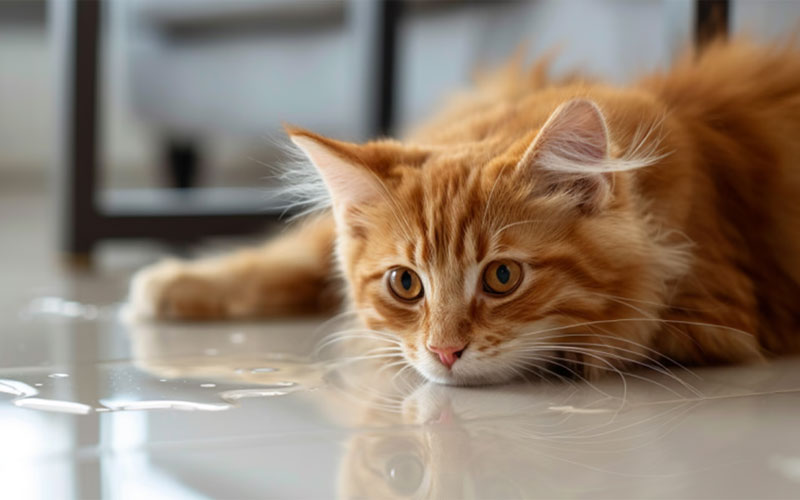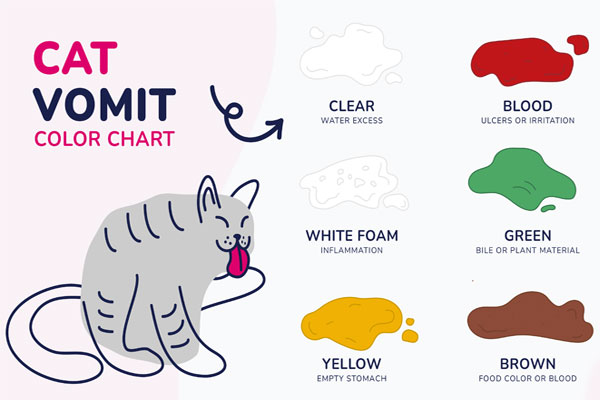
For you as a pet owner, seeing your cat vomit can be worrying. Cats can vomit for many reasons, like eating something they shouldn’t or having health problems. Interestingly, they puke in different colors and even cough up hairballs often.
Since vomiting is common for cats, it’s good to know when to worry. Understanding the colors of the vomit can help you know why it happened and whether you need to see a vet.
Keep reading as this guide will explain what different colors of cat vomit mean and why your cat might be throwing up, including undigested food.
Why is My Cat Throwing Up Undigested Food?
There are many reasons for cats’ throwing up. The type of vomiting (occasional, acute, or chronic) often points to the cause, and it’s best to consult with a veterinarian.
Below we’ve mentioned some common reasons why cats might vomit:
1. Ingestion of Substances
Sudden vomiting often happens when a cat eats something that upsets their stomach. This can range from spoiled food or bitter leaves to more dangerous items like human medicines, poisonous chemicals, or string.
2. Hairballs
Hairballs are clumps of dead hair and digestive juices that form in your cat’s stomach from grooming. When your cat swallows too much hair, it can become a hairball. Vomiting hairballs often include foamy liquid with a glob of hair. Regular brushing helps reduce hairballs. See your vet if your cat vomits hairballs frequently, loses appetite, or seems tired.
3. Bacteria, Viruses, or Parasites
Apart from the above two, certain bacterial and viral infections in your cat’s intestines can cause vomiting. Gastrointestinal parasites can also lead to frequent vomiting if your cat can’t digest food properly.
4. Chronic Disease
Vomiting can indicate several chronic and sometimes hidden diseases. Some common ones include acute kidney failure, acute liver failure, gallbladder inflammation, colitis, gastritis, and pancreatitis. So, if you’re wondering why your cat is throwing up undigested food, there may be a possibility that your cat is suffering from a chronic disease.
5. Change in Diet
A change in your cat’s diet can also cause vomiting. If you’ve recently changed their food, introduced new foods, or started new medication, this could be the reason behind your cat’s vomiting. As a responsible owner, you must look into it, as your cat might experience nausea or indigestion. If diet change is the cause, vomiting should eventually stop.
The Cat Vomit Color Chart

Understanding the different colors of your cat’s vomit can give you clues about their health. Below we’ve created a chart in a tabular form to guide you on what the vomit colors might mean:
Cat Vomit Color |
Meaning |
Causes |
Yellow, Orange, or Brown |
This color may appear when your cat has vomited partially digested food mixed with bile. |
Gastritis, bile reflux, or an empty stomach. |
Red or Pink |
If your cat’s vomit is red or pink, it might mean there’s blood in it, or they could have eaten something that’s colored. |
Gastric ulcers, trauma, or ingestion of colored substances. |
Clear or White |
Clear or white vomit often happens when your cat throws up just saliva or has an empty stomach. |
Acid reflux, esophageal irritation, or an empty stomach. |
Green |
Green vomit can indicate bile or if your cat has eaten something green or with green dye. |
Bile production, ingestion of green plants or food dyes. |
Black or Brown |
Vomit that looks black or brown, similar to coffee grounds, can signal serious bleeding in the digestive system. |
Upper gastrointestinal bleeding, such as from ulcers or tumors. |
Note: Although the chart above might be useful for gaining some idea, you should still consult your veterinarian.
How Vets Identify the Cause of Cat Vomiting?
Cat owners often look at the color and texture of their cat’s vomit to determine why their cat is throwing up. However, it’s not that simple. The color of cat vomit can change based on what they ate, including non-food items, food dyes, and other things. This means that color alone isn’t a good way to diagnose why your cat is vomiting.
If your cat keeps vomiting for a couple of weeks, it could be a sign of serious issues, such as stomach worms, blood parasites, liver problems, stomach infections, kidney diseases, pancreatitis, or a urinary tract infection (UTI).
These problems can’t be easily guessed, so your vet will suggest blood tests, stool and urine tests, X-rays, and ultrasounds. Remember, the choice of test will depend on your cat’s other symptoms, such as weight loss, appetite loss, and depression.
By doing these tests, your vet can discover exactly why your cat is vomiting. He/she will then suggest the best treatment to keep your pet healthy and happy.
Treatments for Cat Vomiting
The best way to treat your cat’s vomiting depends on the underlying cause.
Treatment might not be needed for occasional hairballs, but over-the-counter remedies can be helpful. Medications can also play a key role. Antiemetics like Cerenia control nausea and vomiting, while gastroprotectants like antacids reduce stomach acid. Prokinetics help with gastrointestinal motility issues, and antiparasitics or deworming treatments address parasites. If your cat has a poor appetite, appetite stimulants might be used.
A hypoallergenic or specialized diet can promote gastrointestinal health. Supplements such as prebiotics and probiotics can support normal digestion. Reducing stress and anxiety in your cat’s environment can also help minimize vomiting.
Supportive care is essential for systemic illnesses. Treating the underlying cause, such as hyperthyroidism, kidney disease, or diabetes, can significantly reduce vomiting. Combating dehydration with fluid therapy is crucial, especially if your cat is not drinking enough water. In some cases, surgery may be needed to remove foreign objects or tumors.
Your vet will make a special treatment plan just for your cat to keep it healthy and comfortable.
How Can You Prevent Your Cat From Vomiting
You can start with their diet if you’re looking for ways to prevent your cat from vomiting. Make sure they’re eating good-quality, balanced food. Avoid giving them too many different treats or table scraps without consultation. Keep an eye on what they eat because poor diet or sometimes overeating can upset their stomach and cause vomiting.
Additionally, watch out for non-food items like toy pieces, string, or houseplants, which can lead to digestive problems or blockages. If your cat has specific health issues, like food allergies or digestive diseases, talk to your vet and make a special diet chart for them. Following their advice can help manage these issues and reduce vomiting. Ask your vet about hairball remedies for long-haired cats or those with frequent hairballs. This can help with hairballs and prevent vomiting.
Conclusion
Vomiting is common in cats and can happen for many reasons. Some causes are simple, like hairballs, while others need a vet’s help. Most of the time, it goes away on its own without needing treatment and before a cause is found.
If it doesn’t and you’re worried about your cat, talk to the vet. Provide as much detail as possible so they can decide if more tests or care is needed.



